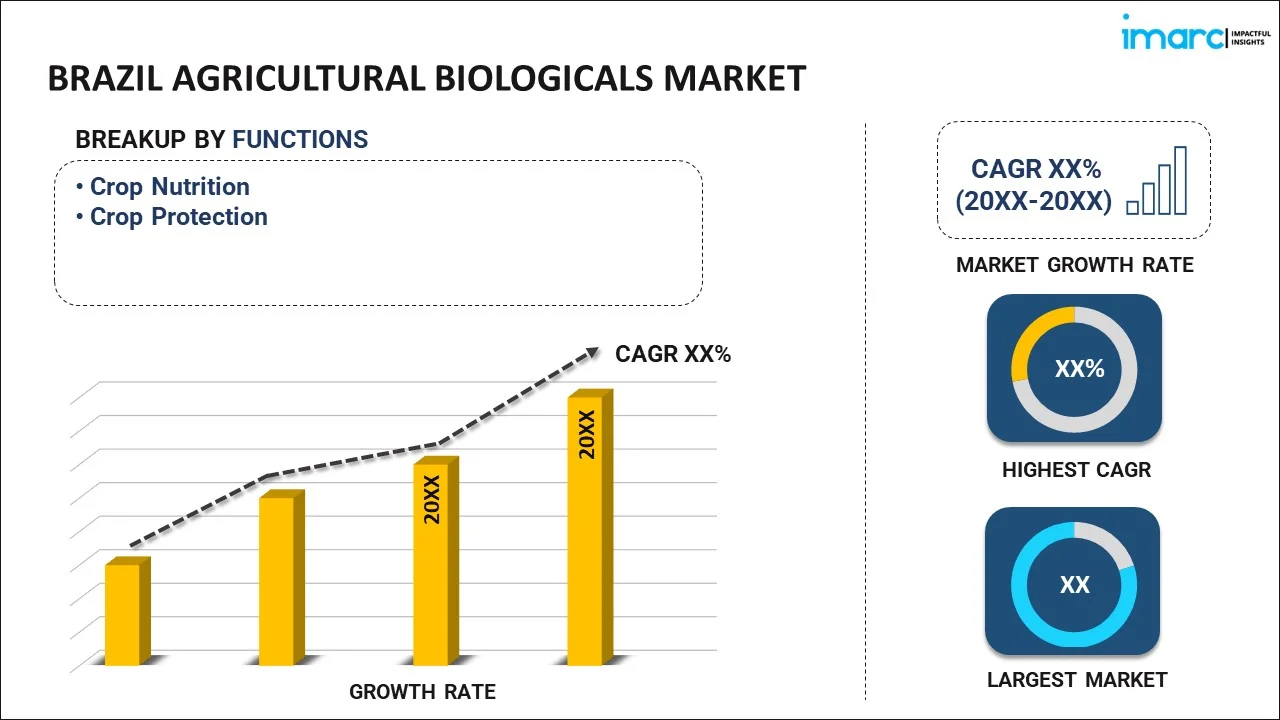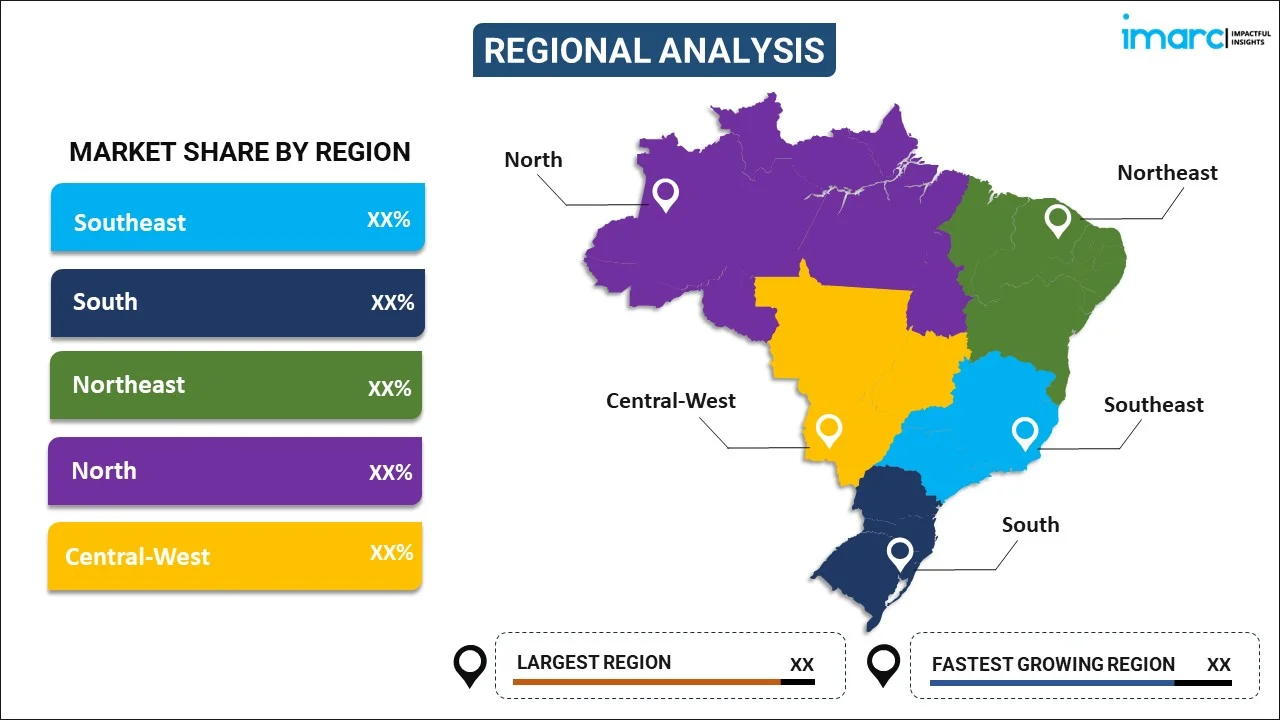
Brazil Agricultural Biologicals Market Report by Function (Crop Nutrition, Crop Protection), Crop Type (Cash Crops, Horticultural Crops, Row Crops), and Region 2024-2032
Market Overview:
Brazil agricultural biologicals market size reached US$ 835.62 Million in 2023. Looking forward, IMARC Group expects the market to reach US$ 1238.3 Million by 2032, exhibiting a growth rate (CAGR) of 4.69% during 2024-2032. The growing shift towards eco-friendly and sustainable farming practices, increasing demand for organic products, and rising awareness about soil health to ensure its fertility for future generations represent some of the key factors driving the market.
|
Report Attribute
|
Key Statistics
|
|---|---|
|
Base Year
|
2023 |
|
Forecast Years
|
2024-2032 |
|
Historical Years
|
2018-2023
|
| Market Size in 2023 | US$ 835.62 Million |
| Market Forecast in 2032 | US$ 1238.3 Million |
| Market Growth Rate (2024-2032) | 4.69% |
Agricultural biologicals refer to a distinct group of farming agents derived from natural materials like microorganisms, plant extracts, and beneficial insects. They play an integral role in enhancing crop productivity and protection, focusing primarily on providing sustainable and environment friendly solutions. They boost crop yield without compromising the health of the soil or the surrounding environment. They work by enriching the soil with essential nutrients, fostering plant growth, and fortifying crops against pests and diseases without chemical interventions. They serve as an alternative to traditional chemical-based fertilizers and pesticides, as they do not leave harmful residues on produce, ensuring the product is safer for consumption. They play a pivotal role in sustaining the health of the soil by preserving its natural nutrient cycle, promoting beneficial microbial growth, and preventing erosion. They are employed across various farming stages like seed treatments, wherein seeds are protected against soil-borne pathogens and pests. They are utilized as soil amendments to restore the microbial balance of the soil, making it more fertile and receptive to crop growth. Furthermore, they enhance plant immunity, making crops resilient against pest attacks and environmental stresses.
Brazil Agricultural Biologicals Market Trends:
The increasing awareness about soil health, aimed at ensuring its fertility for future generations, is impelling the market growth in Brazil. Besides this, collaborative efforts between universities, research institutions, and businesses are encouraging the innovation and commercialization of novel agricultural biologicals. The rich biodiversity of Brazil offers a vast potential for discovering and utilizing unique microorganisms beneficial to crops, which research institutions and companies are actively exploring. Additionally, the advent of digital agriculture, integrating data analytics and precision farming is facilitating the effective application of these biologicals in the country. Moreover, the increasing frequency of extreme weather conditions due to climate change makes crops more susceptible to diseases and pests. This vulnerability propels farmers to use agricultural biologicals that offer a more resilient response to these challenges. Apart from this, the growing awareness about the beneficial properties of agricultural biologicals in improving plant defenses naturally, making them less susceptible to climate-induced stress, is positively influencing the market. In addition, the rising interest of farmers in integrating pest management (IPM) strategies, wherein biological controls play a pivotal role, is propelling the growth of the market in the country. As farmers move away from solely chemical-based solutions, the role of biologicals as part of a holistic crop protection strategy is gaining prominence. The increasing trend of urban and vertical farming in cities is driving the demand for agricultural biologicals. Furthermore, the growing number of aggrotech startups is encouraging innovations centered around biological solutions. These startups, backed by venture capitalists, rapidly develop and commercialize groundbreaking products that cater to niche demands within the broader agricultural biologicals landscape.
Brazil Agricultural Biologicals Market Segmentation:
IMARC Group provides an analysis of the key trends in each segment of the market, along with forecasts at the country level for 2024-2032. Our report has categorized the market based on function and crop type.
Function Insights:

- Crop Nutrition
- Biofertilizer
- Biostimulants
- Organic Fertilizer
- Crop Protection
- Biocontrol Agents
- Biopesticides
The report has provided a detailed breakup and analysis of the market based on the function. This includes crop nutrition (biofertilizer, biostimulants, and organic fertilizer) and crop protection (biocontrol agents and biopesticides).
Crop Type Insights:
- Cash Crops
- Horticultural Crops
- Row Crops
A detailed breakup and analysis of the market based on the crop type have also been provided in the report. This includes cash crops, horticultural crops, and row crops.
Regional Insights:

- Southeast
- South
- Northeast
- North
- Central-West
The report has also provided a comprehensive analysis of all the major regional markets, which include Southeast, South, Northeast, North, and Central-West.
Competitive Landscape:
The market research report has also provided a comprehensive analysis of the competitive landscape in the market. Competitive analysis such as market structure, key player positioning, top winning strategies, competitive dashboard, and company evaluation quadrant has been covered in the report. Also, detailed profiles of all major companies have been provided.
Brazil Agricultural Biologicals Market Report Coverage:
| Report Features | Details |
|---|---|
| Base Year of the Analysis | 2023 |
| Historical Period | 2018-2023 |
| Forecast Period | 2024-2032 |
| Units | US$ Million |
| Scope of the Report | Exploration of Historical Trends and Market Outlook, Industry Catalysts and Challenges, Segment-Wise Historical and Future Market Assessment:
|
| Functions Covered |
|
| Crop Types Covered | Cash Crops, Horticultural Crops, Row Crops |
| Regions Covered | Southeast, South, Northeast, North, Central-West |
| Customization Scope | 10% Free Customization |
| Report Price and Purchase Option | Single User License: US$ 3699 Five User License: US$ 4699 Corporate License: US$ 5699 |
| Post-Sale Analyst Support | 10-12 Weeks |
| Delivery Format | PDF and Excel through Email (We can also provide the editable version of the report in PPT/Word format on special request) |
Key Questions Answered in This Report:
- How has the Brazil agricultural biologicals market performed so far and how will it perform in the coming years?
- What has been the impact of COVID-19 on the Brazil agricultural biologicals market?
- What is the breakup of the Brazil agricultural biologicals market on the basis of function?
- What is the breakup of the Brazil agricultural biologicals market on the basis of crop type?
- What are the various stages in the value chain of the Brazil agricultural biologicals market?
- What are the key driving factors and challenges in the Brazil agricultural biologicals?
- What is the structure of the Brazil agricultural biologicals market and who are the key players?
- What is the degree of competition in the Brazil agricultural biologicals market?
Key Benefits for Stakeholders:
- IMARC’s industry report offers a comprehensive quantitative analysis of various market segments, historical and current market trends, market forecasts, and dynamics of the Brazil agricultural biologicals market from 2018-2032.
- The research report provides the latest information on the market drivers, challenges, and opportunities in the Brazil agricultural biologicals market.
- Porter's five forces analysis assist stakeholders in assessing the impact of new entrants, competitive rivalry, supplier power, buyer power, and the threat of substitution. It helps stakeholders to analyze the level of competition within the Brazil agricultural biologicals industry and its attractiveness.
- Competitive landscape allows stakeholders to understand their competitive environment and provides an insight into the current positions of key players in the market.
Need more help?
- Speak to our experienced analysts for insights on the current market scenarios.
- Include additional segments and countries to customize the report as per your requirement.
- Gain an unparalleled competitive advantage in your domain by understanding how to utilize the report and positively impacting your operations and revenue.
- For further assistance, please connect with our analysts.
 Inquire Before Buying
Inquire Before Buying
 Speak to an Analyst
Speak to an Analyst
 Request Brochure
Request Brochure
 Request Customization
Request Customization




.webp)




.webp)












